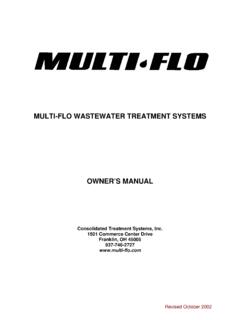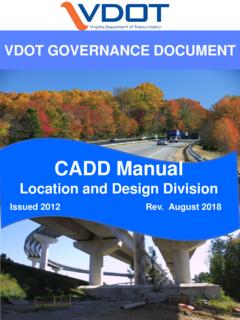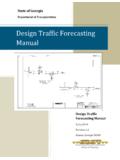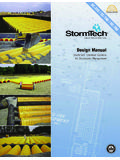Transcription of Nayadic Design Manual - Consolidated Treatment
1 Nayadic WASTEWATER Treatment SYSTEMS Design Manual Consolidated Treatment Systems, Inc. 1501 Commerce Center Drive Franklin, OH 45005 937-746-2727 Nayadic Design Manual Revised August 1, 2002 Consolidated Treatment Systems, Inc. Page 1 Nayadic M-Series Onsite Wastewater Treatment Systems Introduction Onsite wastewater Treatment refers to the process of treating and disposing, dispersing, or recycling of wastewater at or near its point of generation. Historically, the phrase has been synonymous with septic system because that was the only Design alternative available. With the advent of different Design technologies, septic systems are just one of several available alternatives. Because treated wastewater effluent is a valuable resource, owners have the flexibility in how they use this resource.
2 Nayadic systems provide owners with options as to how they treat and recycle wastewater. The suitability and Design of septic systems rely upon native soils to treat and disperse wastewater. In fact, Treatment and dispersal are essentially combined in the same process. For this reason, septic system use is limited to those soils where both functions can be accomplished. Nayadic units allow owners to separate Treatment and dispersal and address each separately. If soil is the selected dispersal alternative, the Design can be based solely upon the ability of the soil to transmit water from the site. Owners may have options, depending on local codes, to use the treated wastewater for beneficial purposes such as recycling into plumbing systems or irrigating gardens and turf.
3 The Nayadic series provides owners with alternatives unavailable to those who rely solely upon septic systems. The Nayadic M-series is capable of treating typical domestic wastewater at a daily flow equal to rated capacities, which are shown in Table 1. The Nayadic M-series Design is based on the same principles as many municipal wastewater Treatment plants. These Design principles have been adapted for the small flows developed by individual residences or small commercial/residential developments. Table 1 Nayadic M-Series Model Rated Flow(gpd) O2 Transfer (Max., lb/day) M-6 500 M-8 600 M-1050 800 M-1200 1000 M-2000 1500 This Manual serves as a guide to Design an onsite wastewater Treatment system using Nayadic units.
4 The Manual includes recommendations for both residential and commercial applications. The recommendations include typical flow data and component suggestions. A failure to consider these recommendations may result in poor unit operation or additional maintenance. Nayadic Design Manual Revised August 1, 2002 Consolidated Treatment Systems, Inc. Page 2 Definitions The following definitions are critical to understanding the Design , installation and operation of Nayadic units. These definitions have been purposely simplified so they can be understood by a wide range of readers. Those desiring detailed information may examine the references listed in the appendix. ANSI/NSF Standard 40: A performance certification standard intended for onsite wastewater Treatment systems having a flow for between 400 and 1500 gpd (gallons per day) and a single point of discharge.
5 CBOD5: The concentration of oxygen (expressed as mg/L) utilized by microorganisms in the non-nitrogenous oxidation of organic matter during a five-day period at a temperature of 20oC. Clarify: A process of separating from wastewater fats, oils, grease, and floatable materials, which float to the surface; and solids, which sink to the bottom. Commercial Occupancy: A building used for commerce or industry. Dispersal: A process for recycling treated wastewater back into the environment. Dosing: A process for periodic discharge of wastewater to a Nayadic unit. Effluent: The discharge from a Treatment component or system. Flow Equalization: A process for mitigating variations in flow by holding wastewater in a tank and dosing the wastewater into the Nayadic unit.
6 Flow Equalization Tank: A watertight, airtight tank, timer, and pumping system having a detention time of from 16-to-24 hours and used to capture and retain solids, grit, and scum and then meter the water into the Nayadic unit through periodic dosing. FOG: Fats, oils, and grease in wastewater. Frequenter: A visitor to and/or customer of a commercial occupancy. Grease Trap: A tank for capturing and retaining fats, oil, and grease. Maintenance: Periodic activities intended to maintain the efficiency and effectiveness of the system. Mixed Liquor. The contents of the Nayadic aeration chamber consisting of, but not limited to, partially treated wastewater and microbial colonies that oxidize the organic material in the wastewater.
7 Nayadic Design Manual Revised August 1, 2002 Consolidated Treatment Systems, Inc. Page 3 Onsite Wastewater Treatment System. A device or combination of devices, which may include tanks, vessels, pumps, aerators, compressors, and other mechanical equipment, intended to treat and disperse wastewater at or near the point of generation. Pre-aeration: Aeration of wastewater to reduce the CBOD5 prior to discharge to the Nayadic unit. Pre-Aeration Tank: A tank used to reduce partially the CBOD5 of the wastewater before the wastewater enters the Nayadic unit. Pretreatment Tank: A watertight, airtight tank having a detention time of from 12-to-24 hours and used to capture and retain solids, grit, and scum before the wastewater enters the Nayadic unit.
8 Residential Occupancy: A building used to house individuals and families. Septic System: An onsite wastewater Treatment system comprised of a septic tank and soil absorption system. Septic Tank: A watertight, airtight tank having a detention time of from 24-to-48 hours, or more, and used to clarify wastewater and capture fats, oil, greases, and inert solids. Soil Absorption System: A system consisting of trenches and pipes or equivalent gravelless devices used to disperse water into the soil where additional Treatment may occur and the water is dispersed from the site. Trash Trap: A watertight, airtight tank for capturing and retaining solids. Seeding: A process for facilitating bacterial growth by providing mixed liquor from another Nayadic unit.
9 TKN (Total Kjeldahl Nitrogen): The quantity of organic nitrogen and ammonia (expressed in mg/L) found in wastewater. TN: The total quantity of nitrogen (expressed in mg/L-N) that exists in the wastewater. Nitrogen may be in the form of ammonia, TKN, nitrate or nitrite. TSS: The quantity of solids (expressed in mg/L) that can be readily removed from a well-mixed sample with standard laboratory filtering procedures. Typical Domestic Wastewater: Wastewater having the characteristics as shown in Table 2: Nayadic Design Manual Revised August 1, 2002 Consolidated Treatment Systems, Inc. Page 4 Table 2 Typical Domestic Wastewater constituent value CBOD5 100-300 mg/L TSS 100-350 mg/L FOG 30 mg/L TKN 60 mg/L Wastewater: Water generated as a result of human activities and containing feces, urine, blood, food byproducts, rinse water, laundry water, process water, and the like.
10 Design Principles The goal of wastewater Treatment is to return to the environment water that does not pose a public health or environmental threat. The role of the Nayadic in this process is to remove from water organic materials and pathogens through biological Treatment . Each model of the Nayadic M-Series has a specific Design rating. Each rating is intended to identify the volume of typical domestic wastewater that the system can treat in a 24-hour period. The flow during this 24-hour period, as tested under ANSI/NSF Standard 40, is shown in Table 3. Table 3 Typical Flow Regime Under ANSI/NSF Standard 40 Time of Day Percent of Total Hydraulic Load 6:00 AM-9:00 AM 35 11:00 AM-2:00 PM 25 5:00 PM-8:00 PM 40 Additional Treatment may be necessary where the flow regime varies from Table 3 and/or the wastewater does not meet the criteria of typical domestic wastewater.









